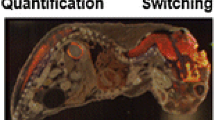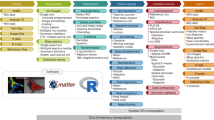Abstract
The choice of colour scheme used to present data can have a dramatic effect on the perceived structure present within the data. This is of particular significance in mass spectrometry imaging (MSI), where ion images that provide 2D distributions of a wide range of analytes are used to draw conclusions about the observed system. Commonly employed colour schemes are generally suboptimal for providing an accurate representation of the maximum amount of data. Rainbow-based colour schemes are extremely popular within the community, but they introduce well-documented artefacts which can be actively misleading in the interpretation of the data. In this article, we consider the suitability of colour schemes and composite image formation found in MSI literature in the context of human colour perception. We also discuss recommendations of rules for colour scheme selection for ion composites and multivariate analysis techniques such as principal component analysis (PCA).

a–t Visualisation of the same data (unnormalised m/z 826 from the cerebellum region of a mouse brain) using colour schemes found in the MSI literature. Intensity spans from 0 to 100 counts. a Grayscale, b red, c green, d blue, e green to white, f cyan to white, g blue to white, h red to white, i pink to white, j copper to white, k hot, l pink hot, m green to yellow, n cyan to magenta to yellow, o double scale (blue to green, red to yellow), p temperature-based, q–t rainbow-based





Similar content being viewed by others
References
Moreland K (2009) Diverging color maps for scientific visualization. In: Bebis G et al. (eds) Advances in visual computing. Springer, Berlin, pp 92–103
Rogowitz BE, Treinish LA, Bryson S (1996) How not to lie with visualization. Comput Phys 10(3):268–273
Borland D, Taylor RM II (2007) Rainbow color map (still) considered harmful. IEEE Comput Graph Appl 27(2):14–17
Light A, Bartlein PJ (2004) The end of the rainbow? Color schemes for improved data graphics. Eos Trans Am Geophys Union 85(40):385–391
Stauffer R, Mayr GJ, Dabernig M, Zeileis A (2013) Somewhere over the rainbow: how to make effective use of colors in meteorological visualizations. Department of Public Finance, University of Innsbruck, Innsbruck
Tkalcic M, Tasic JF (2003) Colour spaces: perceptual, historical and applicational background. In: Eurocon 2003, Ljubljana, Slovenia, 22–24 Sept 2003, 1:304–308
Race AM, Styles IB, Bunch J (2012) Inclusive sharing of mass spectrometry imaging data requires a converter for all. J Proteomics 75(16):5111–5112
Race AM, Steven RT, Palmer AD, Styles IB, Bunch J (2013) Memory efficient principal component analysis for the dimensionality reduction of large mass spectrometry imaging data sets. Anal Chem 85(6):3071–3078
Dougherty B, Wade A (2014) Vischeck. http://www.vischeck.com/. Accessed 24 July 2014
Khatib-Shahidi S, Andersson M, Herman JL, Gillespie TA, Caprioli RM (2006) Direct molecular analysis of whole-body animal tissue sections by imaging MALDI mass spectrometry. Anal Chem 78(18):6448–6456
Adelson EH (1993) Perceptual organization and the judgment of brightness. Science 262(5142):2042–2044
Kimpe T, Tuytschaever T (2007) Increasing the number of gray shades in medical display systems: how much is enough? J Digit Imaging 20(4):422–432
Simunovic M (2009) Colour vision deficiency. Eye 24(5):747–755
Jordan G, Deeb SS, Bosten JM, Mollon J (2010) The dimensionality of color vision in carriers of anomalous trichromacy. J Vis 10(8):1–19
Robichaud G, Garrard KP, Barry JA, Muddiman DC (2013) MSiReader: an open-source interface to view and analyze high resolving power MS imaging files on Matlab platform. J Am Soc Mass Spectrom 24(5):718–721
Parry RM, Galhena AS, Gamage CM, Bennett RV, Wang MD, Fernández FM (2013) omniSpect: an open MATLAB-based tool for visualization and analysis of matrix-assisted laser desorption/ionization and desorption electrospray ionization mass spectrometry images. J Am Soc Mass Spectrom 24(4):646–649
Luo MR, Cui G, Rigg B (2001) The development of the CIE 2000 colour-difference formula: CIEDE2000. Color Res Appl 26(5):340–350
Sharma G, Wu W, Dalal EN (2005) The CIEDE2000 color-difference formula: Implementation notes, supplementary test data, and mathematical observations. Color Res Appl 30(1):21–30
Habekost M (2013) Which color differencing equation should be used? Int Circular Graphic Educat Res 6:20–33
Ware C (2004) Information visualization: perception for design. Elsevier, Amsterdam
Sugiura Y, Konishi Y, Zaima N, Kajihara S, Nakanishi H, Taguchi R, Setou M (2009) Visualization of the cell-selective distribution of PUFA-containing phosphatidylcholines in mouse brain by imaging mass spectrometry. J Lipid Res 50(9):1776–1788
Sodhi RN (2004) Time-of-flight secondary ion mass spectrometry (TOF-SIMS): versatility in chemical and imaging surface analysis. Analyst 129(6):483–487
Pachuta SJ (2004) Enhancing and automating TOF-SIMS data interpretation using principal component analysis. Appl Surf Sci 231:217–223
Cleveland WS, Cleveland WS (1983) A color-caused optical illusion on a statistical graph. Am Stat 37(2):101–105
Brewer CA, Harrower M, Sheesley B, Woodruff A, Heyman D (2014) Colorbrewer 2.0. http://colorbrewer2.org/
Acknowledgements
The authors wish to thank Andrew D. Palmer, Rory T. Steven and Rian L. Griffiths for helpful discussions relating to this work. Funded by EPSRC grant EP/F50053X/1.
Author information
Authors and Affiliations
Corresponding author
Additional information
Published in the topical collection Mass Spectrometry Imaging with guest editors Andreas Römpp and Uwe Karst.
Electronic supplementary material
Below is the link to the electronic supplementary material.
ESM 1
(PDF 4.95 MB)
Rights and permissions
About this article
Cite this article
Race, A.M., Bunch, J. Optimisation of colour schemes to accurately display mass spectrometry imaging data based on human colour perception. Anal Bioanal Chem 407, 2047–2054 (2015). https://doi.org/10.1007/s00216-014-8404-5
Received:
Revised:
Accepted:
Published:
Issue Date:
DOI: https://doi.org/10.1007/s00216-014-8404-5




